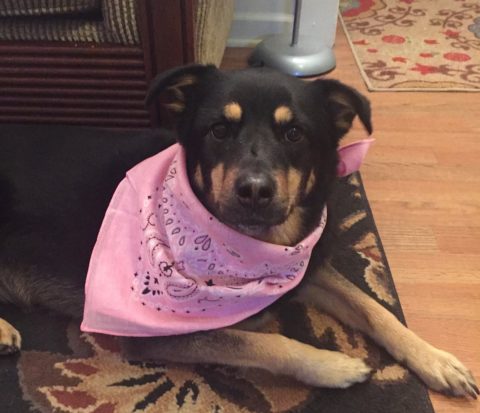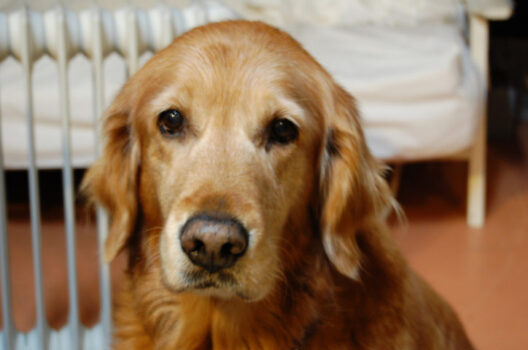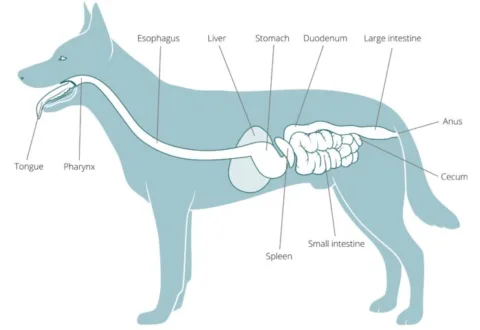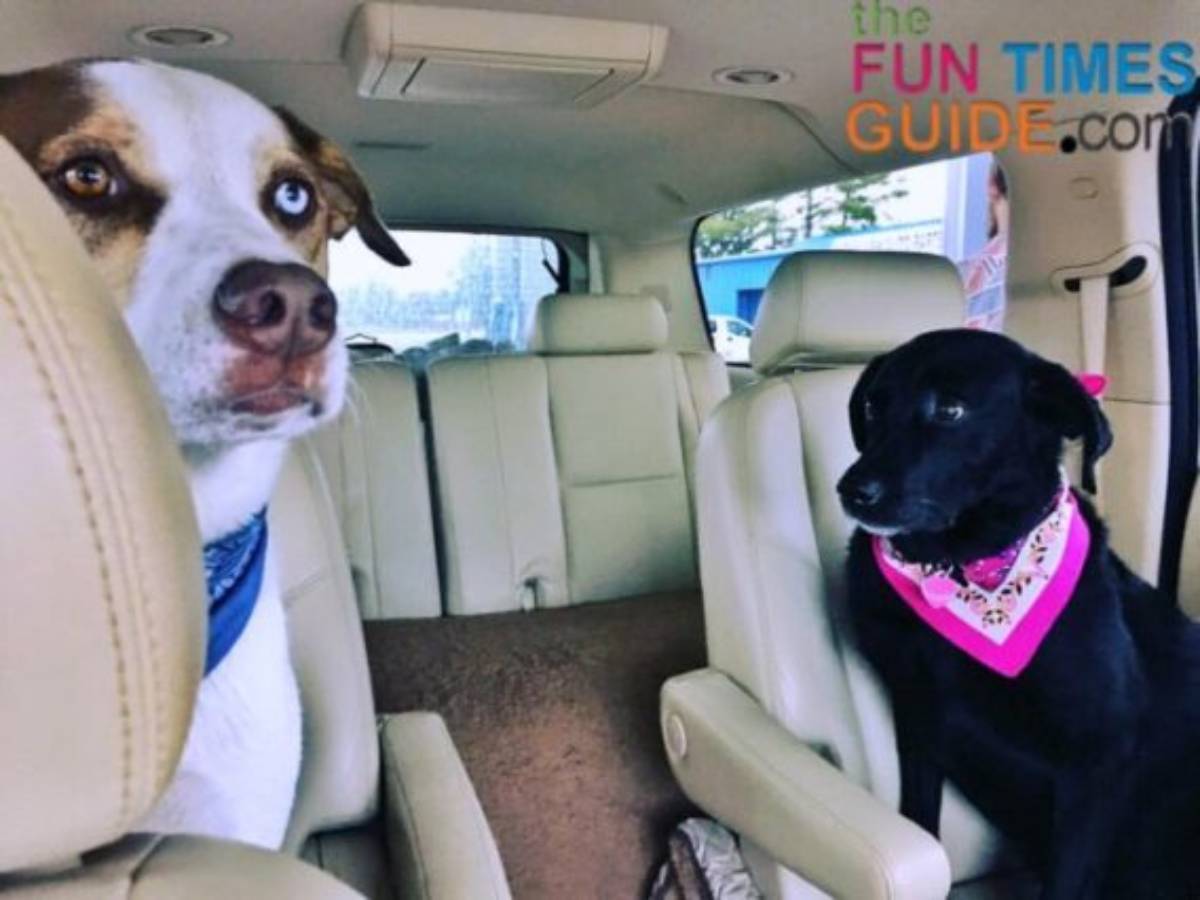Before it happened to my dog, I didn’t know the signs of bloat in dogs. Nor did I realize how serious and life-threatening it is.
Unfortunately, now I know way too much about canine bloat!
Bloat kills about 30% of the dogs it affects — and it’s how my beloved Golden Retriever, Beau, died.
Bloat can kill a dog within minutes. It is a true medical emergency that requires immediate veterinary treatment. Even with immediate care, 25% to 40% of dogs with bloat do not survive.
~ Source
We got Beau as a puppy before we had children. He was our baby. He had an amazing disposition and personality.
He loved the water and loved our first baby so much that his favorite place to sleep was under the crib.
One night shortly after eating his dinner, going for a family walk, and playing with the neighbor’s dog… Beau seemed a tiny bit more subdued than normal. We also noticed that he was trying to vomit, but nothing was coming up. We gave him some water and he seemed a bit better, then it was time for bed.
What happened next — over the course of 36 hours — was devastating.
What follows is my story of losing our dog unexpectedly to bloat and:
- Signs of bloat in dogs that you should watch for.
- Tips for preventing bloat in dogs.
- What to expect if your vet tells you that your dog’s stomach has twisted.
- Some dog bloat treatment options.
5 Important Things You Need To Know About Bloat In Dogs:
#1 – You might not even know your dog has bloat.
The term bloat in dogs could just as easily be called a twisted stomach.
Sounds painful, right? It is.
Dog bloat — also known as gastric dilatation-volvulus (GDV) complex — is a medical and surgical emergency.
Here’s what happens during a gastric dilation-volvulus (GDV):
As the stomach flips, it drags the spleen and pancreas along with it, cutting off the blood flow. The oxygen-starved pancreas produces some very toxic hormones. One, in particular, targets the heart and stops it cold. In fact, a dog can go through successful treatment and seem to be out of danger, when suddenly the heart stops.
~ Source
That is exactly what happened to my beloved Beau.
We had no idea that his stomach had twisted — or how it had become twisted. He was treated quickly, survived life-saving surgery, but died from a heart attack the next day.
#2 – Know the signs — and call your vet immediately if you suspect bloat.
This is the MOST important thing to remember.
In our case, it was 9:30 p.m. on a Sunday night, and we didn’t call the vet. As it turns out… neither do most people.
Some of the signs of bloat in dogs are easy to miss. Beau was dry heaving and I thought it must have been a blade of grass or something bothering him.
He did seem slightly lethargic, but it was at the end of a day, and he had played hard with the neighbor’s Newfoundland… and it was bedtime!
We went to bed as usual — something I regret to this day. I awoke to find Beau curled up in between the back of the toilet and the wall. This was super odd as he usually slept at the foot of the bed, or on the floor on my side of the bed.
I called the vet and little did I know I was describing the symptoms of bloat. She told me to get him in the car and to bring him to her ASAP.
TIP: One of the most obvious symptoms of bloat in dogs is an enlarged abdomen — but my dog’s stomach was not at all distended.

You may also see these signs of bloat in dogs:
- Labored breathing.
- Drooling a lot more than normal.
- Trying to vomit but nothing comes up.
- Having a rapid heartbeat, but a weak pulse.
- Having a pale nose and mouth (might even look whiteish — which is a sign of shock).
Beau was in the early stages of canine shock, and we didn’t even know it.
Here’s a super helpful step-by-step chart showing what to do right away if you suspect bloat.
This video shows how to check your dog’s vital signs:
#3 – Even if you treat the bloat, your dog might still die.
If there’s any suspicion of bloat, take your dog to the nearest vet hospital. If the stomach has twisted, then emergency surgery is the only option.
The only way to treat it is to go into their abdomen surgically and untwist the stomach. The stomach is then sutured to the body wall to prevent it from twisting again. This is called a gastropexy.
~ Source
According to our veterinarian, most of the dogs with bloat she saw in her office were already in shock and didn’t usually survive the surgery. She stated that most owners don’t recognize the signs of bloat in time — and the sad truth is that most often her clients thought their dogs were just tired. They would leave for work and come home to an unresponsive (or deceased) pet.
So after patting us on the back (literally), she told us Beau needed emergency surgery to try to flip the stomach back around, and she was going to have to staple it to the inside of his body so that it wouldn’t be likely to happen again.
So we signed the papers to allow all necessary measures to ensure that Beau would be ok. After an excruciating afternoon waiting for the surgery results, we were thrilled to hear he made it through the surgery — and we could go see him!
This is the part of the story where it’s hard for me not to get emotional because we questioned each one of these steps during (and after) Beau died.
After Beau had his life-saving surgery for bloat:
- We were told we had to transport our dog to an emergency 24-hour vet — because our vet that performed the surgery was not able to stay open overnight and monitor his progress. Let me reiterate… we were told WE HAD TO TRANSPORT our Beau who was in post-surgical critical condition.
- Beau was unhooked from his life-saving monitoring devices and fluid bags and we drove him in our Jeep (bouncing and worrying that he could throw a stroke at any minute).
- The emergency vet took Beau (he was lifted in and out of the vehicle by us) and he was again hooked up to fluids and monitoring devices. I made sure I knew everyone’s name, and they told me for the 4th time they had it under control. (I called to check on him 4 times overnight — they said he was making a “miraculous” recovery.)
- We were told to pick him up first thing in the morning and to transport him BACK TO OUR VET — and if all went well, we would be able to take him home that very next day. That. Didn’t. Happen.
TIP: If your dog needs emergency surgery, choose a location that will stay open 24 hours. This could save your dog! Here’s how to find an emergency 24-hour vet near you.
- We arrived to pick up Beau and take him back to our vet for continued observation and post-surgery care. He was again unhooked from all of his fluids and monitoring devices and he jumped into our car. (I remember cringing at this thinking, “How can he feel so good to jump into the car?”)
- We arrived at the vet and he was hooked back up to monitoring devices and fluids after he went to the bathroom with me outside. I had to go to work and was going to check on him at lunch (I worked about 5 minutes down the street). When I left he was sitting in his crate in the vet’s office.
- I walked across the street to get a cup of coffee — and was called when I was in line to order — that he had just died from a heart attack and I should come right back. I think he waited until I left the building — he was special that way.
#4 – Preventing bloat in dogs is very difficult to do, but it’s good to know the risk factors.
The most common denominator among dogs who’ve experienced bloat is anatomical — being a larger, deep-chested dog.
Here’s a list of dog breeds that are more susceptible to bloat. Just keep in mind… while the dogs on that light might be more susceptible, they’re not the only breeds to suffer from bloat. And small dogs can get bloat too!
Breeds with deep chest cavities — such as German Shepherds, Dobermans, Greyhounds and Great Danes — are more likely than others to develop a GDV. This is because of their anatomy, where the deep chest means their stomach is suspended in the abdomen — like a hammock from 2 trees. If there is a weight in the stomach (i.e., food) and the dog then rolls or goes for a run, the stomach swings on its mountings and potentially flips over. The twisted stomach is a sealed unit, and gas produced as a result of digestion cannot escape. Thus pressure builds up inside the stomach, causing it to swell. The blood supply to the twisted stomach is cut off, and this piece of bowel rapidly dies off. A combination of toxins, circulatory collapse, organ failure and shock means this condition is almost certainly fatal without treatment.
~ Source
Other risk factors that increase the chances of your dog developing bloat include:
- Having a close canine relative that has experienced GDV.
- Having a rambunctious personality.
- Being stressed.
- Eating only one meal per day.
- Eating very quickly.
The likelihood that your dog will have an incident of bloat increases with age — there is a 20% increase in risk with each year of age.
Here’s how to tell if your dog is at risk for bloat.
#5 – Bloat is often deadly — but it’s not your fault.
We don’t know exactly why GDV happens. Some people do all of the “wrong” things, and their dogs don’t experience it, while some do all of what we think are the “right” things, and their dogs do.
~ Source
Beau died after extremely intensive treatment and life-saving surgery to flip his twisted stomach.
The surgery was around $2,500, and we also had to pay for the overnight care. Of course, money was insignificant at the time — we just wanted our Beau to survive.
So, we’ll never really know what caused Beau’s stomach to twist, but our vet did tell us a few things that might have contributed to our dog’s bloat:
- We only fed him one meal a day and it was dinner.
- We allowed him to play rigorously with another dog shortly after eating.
Constantly watching for the signs of bloat in dogs can seem overwhelming — like you always have to be on high alert. But it’s worth it!
The Bottom Line (And Some Good News!)
Canine bloat is a serious, life-threatening condition that you cannot prevent — you can only watch your dog closely and try to eliminate as many risk factors as possible.
Now that you know the risk factors and signs of bloat in dogs, you have a better idea of what to watch for!
What does seem to help is feeding your dog more than once daily — 2 to 4 times is ideal. Slowing down the rate at which your dog eats using food puzzles also may help. Avoid high fat diets or those with added oils high on the ingredient list. If your dog is at risk, consider having preventive surgical gastropexy performed. Age, breed, family history, fear or stress, food gulpering, and once daily feedings all seem to be more important factors [than the type of dog food you’re serving] in the development of bloat and GDV. If you have a large- or giant-breed dog, talk to your veterinarian about how to reduce the chances your dog will develop this terrifying situation. Now go get a food puzzle and use it 2 or more times a day.
~ Source
Now a bit of good news…

Since losing Beau to bloat, I’ve changed some routines for Bella — who is my best companion these days. I also keep an eye out for signs of bloat in dogs (mine and others… I can’t help myself).
Bella will eat her food very quickly — if I let her.
So, to reduce the chances of Bella getting bloat, I…
- Feed her 2 small meals during the day, rather than 1 large meal.
- Try to get her to eat slowly. (There are dog food bowls that help dogs eat more slowly.)
- Limit her activity, as best I can, right after eating.
- Monitor her behavior for about 30 minutes after mealtime.
I’ll be the first to admit, I’m not perfect or necessarily diligent at meal time — every single time — but I do my best.
If your dog gobbles up her food like Bella does, try one of these slow feed dog bowls.
And here’s some more good news: some dogs do survive!
This video provides a great description of bloat and how a dog named Hazel survived her bout with bloat:
And finally, check out this happy ending for a dog named Griff, who battled with GDV.
Hopefully, I’ve lessened your anxiety and you’ve learned something about what dog bloat is, why it happens, and how it’s treated — so if the unthinkable happens, you’ll get right in the car, head to the vet, and yours will be one of the dogs that survive.






